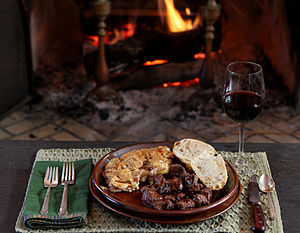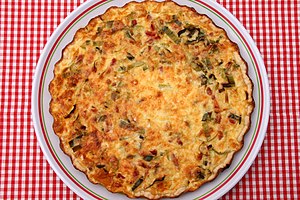Yonderian cuisine

Yonderian cuisine, known in Burgoignesc as cuisine Yonderresc and in Gothic as Yondersche Küche, is the collective term for the styles of cooking associated with Yonderre famous worldwide not least thanks to Yonderian cinema. Yonderian cuisine originated as the mixture of the Gothic peasant population's own local produce and the cooking styles and mannerisms of the Burgoignesc nobility. It was enhanced by cooking techniques developed in the mid-nineteenth century and the wider availability of goods during and after the Yonderian Golden Age and industrial revolution. Ground meats (pork, veal or beef) became widespread during the industrial revolution and traditional dishes that are still popular includes meat balls, breaded pork patties and sausages. Yonderre is known for its beers, fine wines, pastries and and herbal liqueurs such as Chevaleuer Verte worldwide, all of which are widely exported with relatively little import of the same to Yonderre.
As the crossroads of central Levantia, cooking in Yonderre has always been inspired by foreign and continental practises and the use of imported tropical spices like cinnamon, cardamom, nutmeg and black pepper can be traced to the Yonderian cuisine of the Middle Ages and some even to the Khovihnihk peoples who inhabited northern Yonderre until the Great Gothic Migration in the late sixth century. Yonderian cuisine as a definitive singular category came about as a concept during the Yonderian Golden Age in the mid-nineteenth century, seeking to merge the many regional cuisines and specialities into a single, combined cuisine. The concept was largely succesful although regional specialities remain, enabling culinary tourism to thrive since.
History
Ancient history
Middle Ages
Burgoignesc Yonderre
Structure of meals
Breakfast
Lunch
Dinner
Staples
Alcoholic drinks

Beer is a very common and culturally and historically important part of Yonderian cuisine, with countless local and regional breweries producing a wide variety of beers. Imported beer accounted for only 8% of total volume sales in 2016, indicating that beer sales in Yonderre are dominated by domestic brands. The lasting impact of Yonderian beer brewing is seen worldwide; S. Tuburgensis, the yeast instrumental in brewing modern Lager beers, was developed by chemists at Toubourg Monastery in service of their brewery in 1866, and indeed the word Lager itself is of East Gothic origin, with Lagerbier, literally “Camp beer”, being the beverage of choice of encamped Yonderian armies since the early renaissance.
Beer is known to have been brewed in East Gothica since at least 3000 BC, although early Gothic beer might not be recognised as beer by most people today, often being spiced with fruits and herbs and the primary difference being the usage of bayberry in place of hops. Hops were introduced from the Holy Levantine Empire in the early ninth century and prompted more organized brewing. Beer was brewed on a domestic basis, with many households brewing their own relatively low-alcohol beer in cellars, nicknamed Kellerbier, literally “Cellar beer”. Stronger ales were generally only brewed at courts or alehouses, supplemented by either locally brewed or imported wines and liqeurs.
Wine has been grown in southern Yonderre since at least 1000 BC, although it wasn't until the eighth century AD that teachings as well as new grape sorts from the Hole Levantine Empire enabled the East Goths in Södarland to more effectively organize their efforts. Following the mid-fifteenth century Conquest of Joanusterre by the knights of the Order of the Obsidian Sparrow, large-scale brewing of wine, beer and herbal liqueurs began in the new monasteries and abbeys. In the early sixteenth century a large tax was levied on wine in a futile attempt to curtail excessive drinking which lead to a monumental increase in the brewing of beers and liqueurs instead.
Breads

Rye bread, known in Burgoignesc as pain neir and in Gothic as Schwarzbrot, "black bread" in Julian Ænglish, has been a staple of Gothic cuisine since ancient times, owing in no small part to the hardyness of rye which allows it to grow all over the country. Eating rye bread was looked down on by the Burgoignesc nobility following the Conquest of Joanusterre, who themselves preferred lighter breads made from wheat (spelt) or other grains. It remained as a staple food of the Gothic workers and peasants however throughout the renaissance and into modern times, where during the Yonderian Golden Age the attitude towards rye bread turned and it in fact became fashionable as a lunch item. Rye bread is almost exclusively eaten with a topping, usually a cold cut of meat, paté or salads. Sourdough is almost always used for the base dough, as commercial yeasts are unsuitable.
Lighter breads made from grains like wheat were more expensive due to the higher prices of other grains compared to that of rye, a trend that continued until the industrial revolution in spite of repeated attempts to grow more wheat in southern Yonderre. Because of the social stigma carried from eating rye bread, poor burghers often resorted to buying breads made from mixed flours, known as pain mulâtre or "mulatto bread". "Cutting the bread with rye" remains an idiom in Yonderre, meaning to skimp on something. Bread was a significant food source among peasants and the working class into the late 18th century, with many of the nation's people being dependent on it. In the countryside, bread was often consumed three times a day by the peasantry. During the industrial revolution, master bakers in Collinebourg invented new methods of baking spiced speciality breads that remain popular into modern times.
Pastries

Pastries, known in Burgoignesc as Rouléeserie ("Rolled thing"), are baked goods made from a yeast-leavened dough in a manner similar to bread with added ingredients (particularly eggs, butter, milk, cream and sugar) giving them a richer, sweeter character. The dough is often laminated, being formed of many thin layers atop one another. Pastries are an important aspect of Yonderian cuisine, being one of the cornerstones of the full Yonderian breakfast. Pastries are also consumed as snacks, particularly with afternoon coffee.
The modern style of Yonderian pastries originated in Collinebourg, Yonderre in the early 19th century out of previous simpler pastries like sweet rolls and confectionery. They were initially viewed as a delicacy for the upper class due to the price of expensive spices like cinnamon and cardamom often used, but soon earned their place as a common breakfast item for the ordinary folk. Yonderian pastries come in many variants, sizes and shapes. They are generally named after the town or region they originated in, although some take their names from historical events or characters.
Roasts
Sauces
Quiche

Quiche is a traditional Yonderian tart or pie consisting of pastry crust filled with egg, cream and cheese and optionally a combination of meat, seafood and/or vegetables. Quiches may be served hot, warm or cold. Smaller quiches with a diameter around 12 centimetres (4.7 in) are common as lunch items in Yonderre and are available from most supermarkets, bakeries, butchers and even some cheese shops, while larger quiches the size of dinner plates are common dinners.